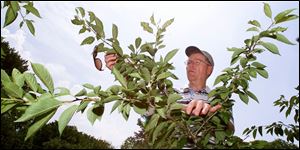
Historical Japanese gift to get fresh life at BGSU
7/26/2001
Dr. Reginald Noble checks on one of the cherry saplings at the Schedel Arboretum and Gardens in Elmore.
BOWLING GREEN - A bit of history is about to take root at Bowling Green State University.
Three Yoshino cherry trees - clones of the ones that Japan gave to the United States as a token of friendship in 1912 and which remain a popular tourist attraction along Washington's Tidal Basin - soon will find a home on campus as part of a beautification project.
Aside from a couple of trees that have gone to events in Washington, BGSU is the only institution in the country given the tree cuttings from the National Park Service and U.S. National Arboretum, arboretum officials said. “It's a really, really neat project,” said Paul Pawlaczyk, assistant director of alumni affairs at BGSU. “Basically, it started about 88 years ago when Helen Taft, [President] William Howard Taft's wife, accepted a gift of cherry blossom trees from the government of Japan.”
Those trees were a thank you to Mr. Taft, the great-grandfather of Ohio's current governor, for his support during the Russo-Japanese War in 1905 when he was U.S. Secretary of War. Now, a bit of luck and the support of eight people in Japan with BGSU connections promise springtime showers of light pink cherry blossoms on campus for years to come.
Spearheaded by Masatoshi Emori, Takuo Imada, and Akira Koito, all of whom attended BGSU in the late 1960s, a decision was made to purchase 50 cherry trees as a gift to the university.
They wanted to ship over Japanese trees, but the complications were too many, said Dr. Reginald Noble, director of the Schedel Arboretum and Gardens in Elmore and a former BGSU professor.
Dr. Noble, with connections at the national arboretum, had another idea.
“I suggested that we get three symbolic trees from the trees growing around the Tidal Basin and grow them up as a symbol of the Japanese trees and plant the remainder of the growth using U.S. nursery stock,” he said.
That was two years ago, about the time the U.S. National Arboretum was raising genetic clones of the original cherry trees to replace dying ones.
At the time, only 125 Yoshino cherry trees, which live an average of 47 years, remained of the original 3,000, according to information from the U.S. Department of Agriculture.
“Those were special because they were the original germplasm [genetic material] that came over from Japan,” said Dr. Margaret Pooler, a research geneticist at the national arboretum.
“It just happened that Reginald came by at the time that we still had a few extras that we hadn't given back to the park service, so he got those,” she said. “It was kind of a one-time deal that they happened to be in the right place at the right time.”
The university was given four cuttings to grow into new trees, one of which will serve as a back-up in the Schedel Arboretum, where all four are being nurtured.
The cherry trees are expected to be planted during the coming months in a new park on the east side of campus, near Alumni Drive and Mercer Road. A man-made pond at the site with a history of leaking has been filled in, and there are plans to supplement the 53 cherry trees with 500 evergreen shrubs and 11 park benches, said Doug Smith, vice president for university advancement.
The BGSU Alumni Association expects to spend about $100,000 on the project, and the 50 cherry trees cost about $5,000.
A dedication ceremony is set for Oct. 4 for the park, which is intended as a place for reflection and a symbol of BGSU's tradition of international programming.